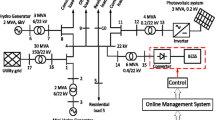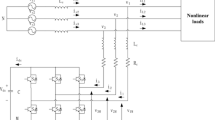Abstract
A single phase grid connected photovoltaic (PV) system is susceptible to a number of power quality (PQ) problems, including power factor, harmonic current, voltage fluctuations, and load unbalance. Compensation is needed to address these PQ concerns. In this study, a single phase shunt active power filter is presented to handle power quality issues using novel and straight forward radial basis function neural network (RBFNN) controller architecture and to ensure maximum power flow between PV and grid using a maximum power point tracker control technique. The design takes into account a single neuron in the hidden layer, and the network is trained on-line to be suitable for inverter control to reduce power quality (PQ) issues. The newly developed controller has a single input for the load current and is able to isolate the fundamental component of the current. Tracking is fast and achieved within one cycle. The trained model shows exceptional results for load compensation under various loading conditions. With the suggested RBFNN controller, both findings from simulation and from experiments have been shown to work.













Similar content being viewed by others
References
Belaidi R, Hatti M, Haddouche A, Larafi MM (2013) Shunt active power filter connected to a photovoltaic array for compensating harmonics and reactive power simultaneously. In: 4th international conference on power engineering, energy and electrical drives. pp 1482–1486. https://doi.org/10.1109/PowerEng.2013.6635834s
Haque A, Zaheeruddin (2013) Research on solar photovoltaic (PV) energy conversion system: an overview. In: Third international conference on computational intelligence and information technology (CIIT 2013). pp 605–611. https://doi.org/10.1049/cp.2013.2653s
(2020) Solar–10 predictions for 2022. BNEF – Bloomberg new energy finance. Retrieved 1 Feb 2022
Szemes PT, Melhem M (2020) Analyzing and modeling PV with “P&O” MPPT algorithm by MATLAB/SIMULINK. In: 2020 3rd international symposium on small-scale intelligent manufacturing systems (SIMS). pp 1–6. https://doi.org/10.1109/SIMS49386.2020.9121579
Juamperez M, Yang G, Kjær SB (2014) Voltage regulation in LV grids by coordinated volt-var control strategies. J Mod Power Syst Clean Energy 2:319328. https://doi.org/10.1007/s40565-014-0072-0
Singh B, Chandra A, Al-Haddad K (2015) Power quality: problems and mitigation techniques. Wiley, New Jersey
Ghosh A, Ledwich G (2009) Power quality enhancement using custom power devices. Springer, Delhi
Chittora P, Singh A, Singh M (2018) Chebyshev functional expansion based artificial neural network controller for shunt compensation. IEEE Trans Ind Inf 14(9):3792–3800
Reddy SS, Bijwe PR (2015) Real time economic dispatch considering renewable energy resources. Renew Energy 83:1215–1226
Badoni M, Singh A, Singh B (2016) Comparative performance of wiener filter and adaptive least mean square-based control for power quality improvement. IEEE Trans Ind Electron 63(5):3028–3037. https://doi.org/10.1109/TIE.2016.2515558
Sanjan S, Yamini NG, Gowtham N (2020) Performance comparison of single-phase SAPF using PQ theory and SRF theory. In: 2020 international conference for emerging technology (INCET). pp 1–6. https://doi.org/10.1109/INCET49848.2020.9154126
Akagi H (1996) New trends in active filters for power conditioning. IEEE Trans Ind Appl 32(3):1312–1322
Akagi H, Kanazawa Y, Nabae A (1983) Generalized theory of the instantaneous reactive power in three-phase circuits. In: Proc. IEEJ int. power electron. conf., Tokyo, Japan. pp 1375–1386
Raj GS, Rathi K (2015) P-Q theory based shunt active power filter for power quality under ideal and non-ideal grid voltage conditions. In: 2015 international conference on power, instrumentation, control and computing (PICC). pp 1–5. https://doi.org/10.1109/PICC.2015.7455754
Li H, Zhuo F, Wang Z, Lei W, Wu L (2005) A novel time-domain current-detection algorithm for shunt active power filters. IEEE Trans Power Syst 20(2):644–651. https://doi.org/10.1109/TPWRS.2005.846215
Girgis AA, Chang WB, Makram EB (1991) A digital recursive measurement scheme for on-Line tracking of power system harmonics. IEEE Trans Power Del 3:1153–1160
Singh B, Arya SR (2014) Back-propagation control algorithm for power quality improvement using DSTATCOM. IEEE Trans Ind Electron 61(3):1204–1212
Arora A, Singh A (2019) Design and analysis of functional link artificial neural network controller for shunt compensation. IET Gener Transm Distrib 13(11):2280–2289
Arora A, Singh A (2019) Design and implementation of Legendre-based neural network controller in grid-connected PV systems. IET Renew Power Gener 13(15):2783–2792
Saxena H, Singh A, Rai JN (2020) Adaptive spline-based PLL for synchronisation and power quality improvement in distribution system. IET Gener Transm Distrib 14(7):1311–1319. https://doi.org/10.1049/iet-gtd.2019.0662
Mehrankia A, Mollakhalili Meybodi MR, Mirzaie K (2022) Prediction of heart attacks using biological signals based on recurrent GMDH neural network. Neural Process Lett. https://doi.org/10.1007/s11063-021-10667-8
Panda S, Panda G (2021) On the development and performance evaluation of improved radial basis function neural networks. IEEE Trans Syst Man Cybern Systs. https://doi.org/10.1109/TSMC.2021.3076747
Mishra S (2006) Neural-network-based adaptive UPFC for improving transient stability performance of power system. IEEE Trans Neural Netw 17(2):461–470
Dash PK, Mishra S, Panda G (2000) A radial basis function neural network controller for UPFC. IEEE Trans Power Syst 15(4):1293–1299
Jie H, Zheng G, Zou J, Xin X, Guo L (2020) Speed regulation based on adaptive control and RBFNN for PMSM considering parametric uncertainty and load fluctuation. IEEE Access 8:190147–190159
Luo Y, Zhao S, Yang D, Zhang H (2020) A new robust adaptive neural network backstepping control for single machine infinite power system with TCSC. IEEE/CAA J Autom Sin 7(1):48–56
Baghaee HR, Mirsalim M, Gharehpetan GB, Talebi HA (2018) Nonlinear load sharing and voltage compensation of microgrids based on harmonic power-flow calculations using radial basis function neural networks. IEEE Syst J 12(3):2749–2759
Jiang L, Wu C (2018) Application of the improved RBFNN based on DPC in monthly rainfall forecasting. In: 2018 IEEE international conference of safety produce informatization (IICSPI). pp 853–857
Lei X, Lu P (2014) The adaptive radial basis function neural network for small rotary-wing unmanned aircraft. IEEE Trans Ind Electron 61(9):4808–4815
Lyashevskiy S, Yaobin C (1997) The Lyapunov stability theory in system identification. In: Proceedings of the 1997 American control conference (Cat. No.97CH36041), vol 1. pp 617–621, https://doi.org/10.1109/ACC.1997.611873
Bajaj M, Flah A, Alowaidi M, Sharma NK, Mishra S, Sharma SK (2021) A lyapunov-function based controller for 3-phase shunt active power filter and performance assessment considering different system scenarios. IEEE Access 9:66079–66102. https://doi.org/10.1109/ACCESS.2021.307524
Author information
Authors and Affiliations
Corresponding author
Additional information
Publisher's Note
Springer Nature remains neutral with regard to jurisdictional claims in published maps and institutional affiliations.
Rights and permissions
Springer Nature or its licensor (e.g. a society or other partner) holds exclusive rights to this article under a publishing agreement with the author(s) or other rightsholder(s); author self-archiving of the accepted manuscript version of this article is solely governed by the terms of such publishing agreement and applicable law.
About this article
Cite this article
Singh, A., Pandey, A. Performance of adaptive radial basis functional neural network for inverter control. Electr Eng 105, 921–933 (2023). https://doi.org/10.1007/s00202-022-01706-1
Received:
Accepted:
Published:
Issue Date:
DOI: https://doi.org/10.1007/s00202-022-01706-1




